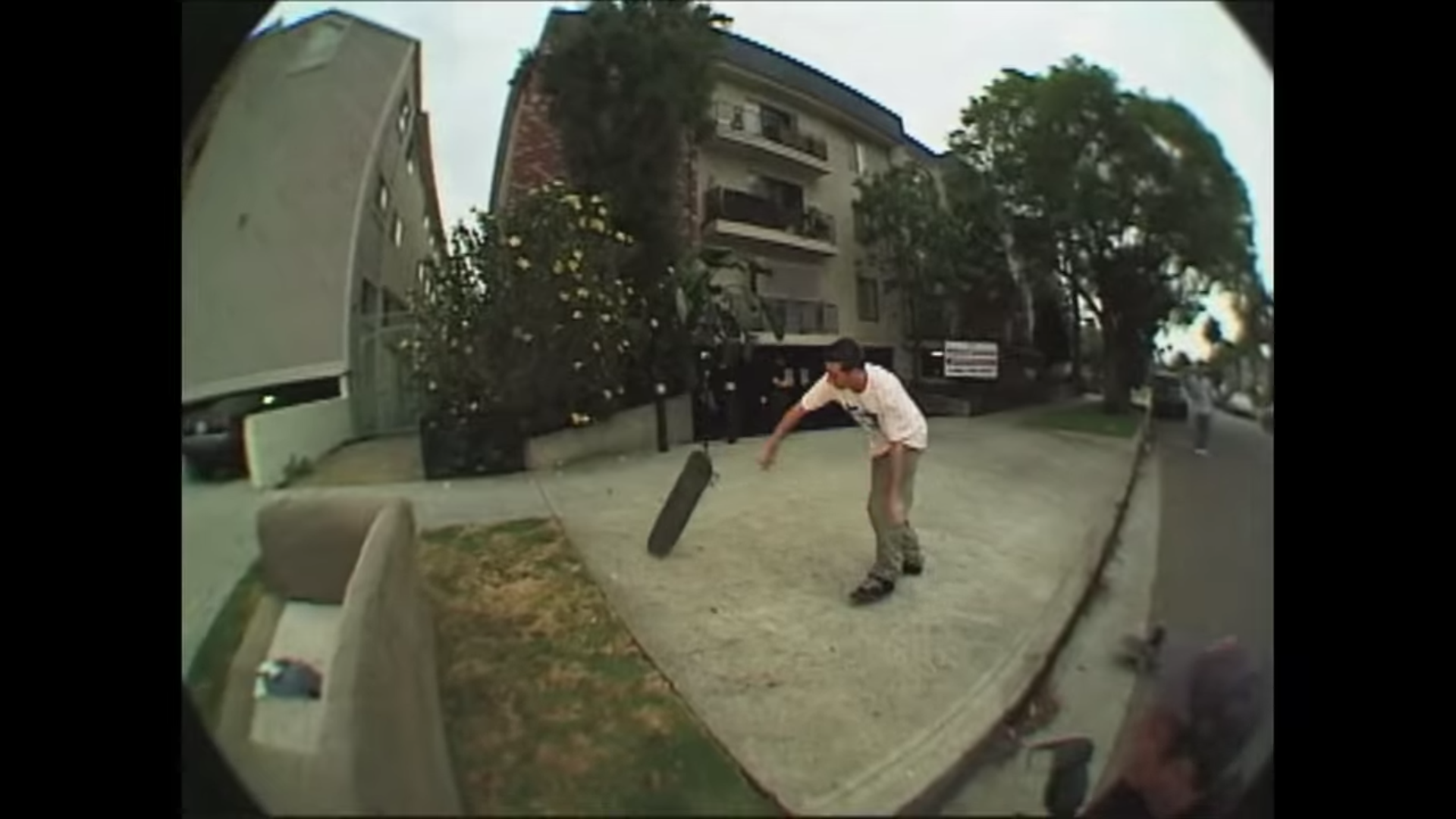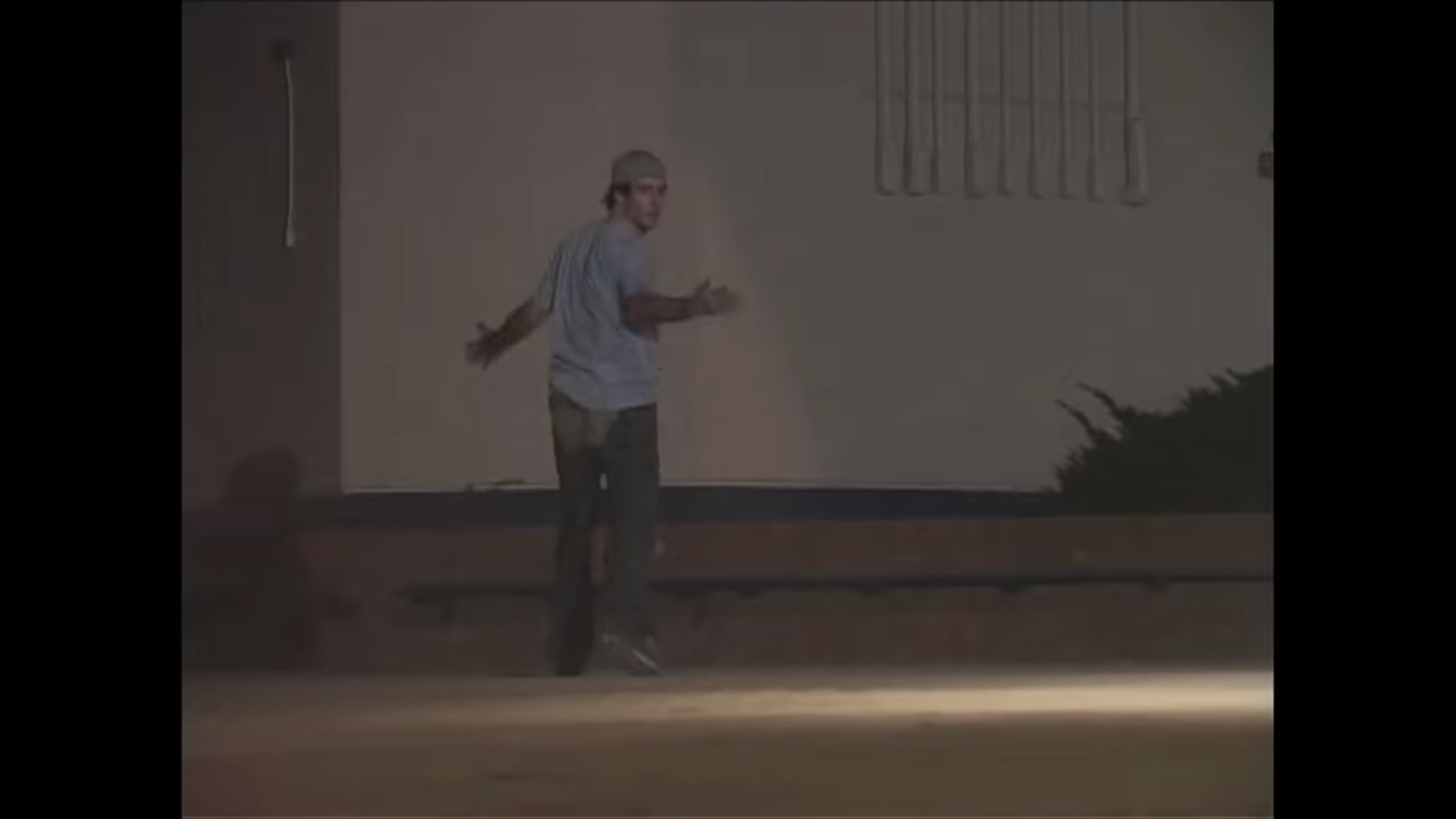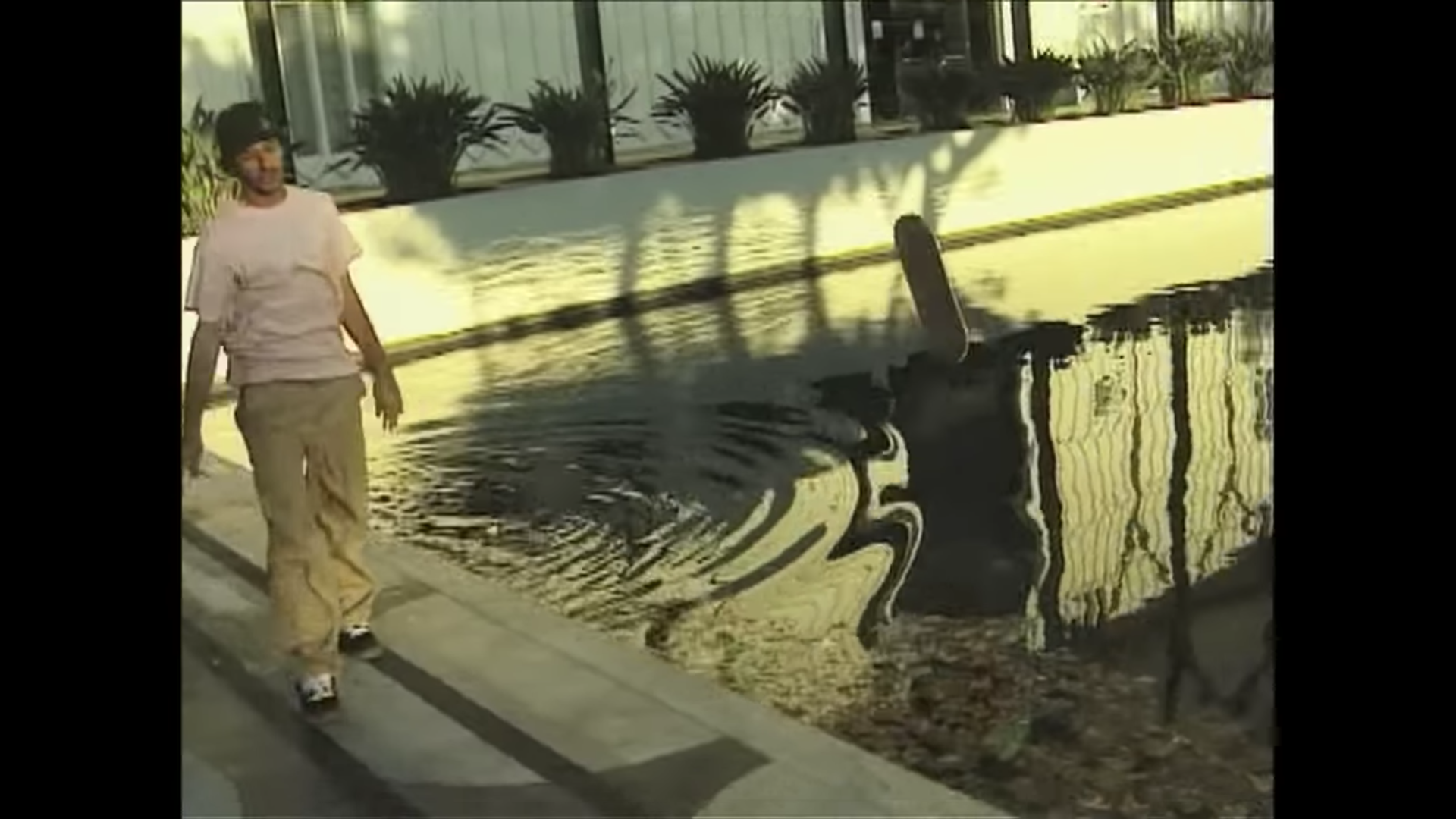It probably wasn’t the first time I saw someone break a skateboard, or the most aggressive, but watching Mike Carroll’s part in Yeah Right (2003) revealed to me the full emotional complexity of focusing—aka breaking—one. The introduction is a fast-paced montage of destruction. He spears his board nose-first into the ground, intending to splinter it. He pitches it headlong at a picnic table, the board spinning end to end like the menacing rotors of a helicopter. He slaps it on the ground so hard, it bounces back up head high. In perhaps the most emotional clip of the entire montage, he doesn’t actually throw the board. Instead, he throttles it, clasping it to his person like some Shakespearian character wracked with betrayal. Throughout the montage, Carroll’s performance runs the gamut of masculine rage, but in the only depiction of him actually breaking a skateboard, he eschews emotion for violent efficiency, as if to merely illustrate that he can, and that it is as simple as foot meets board. At fourteen, I was mesmerized by all of it, as much, and perhaps more than the skateboarding that followed.
There were many things that attracted me to Carroll’s performance. He was loud, aggressive, but most of all, the outcome of his behavior resembled a performance, meaning whatever personal consequences he sustained—such as a broken skateboard—were part of the act, even coming off as playful. Somehow, it connected to the anger I experienced at home: my Dad yelled, and sometimes he yelled at me, but his short-tempered anguish would ultimately be considered out of character, an outburst. Here was an arena that granted me the same privilege as my Dad enjoyed at home, a masculinity that didn’t require me to take my anger seriously—like my constant recitations of Simpson’s quotes during the same period, these emotional expressions could always be dismissed or celebrated as playtime, artful, witty, or ironic, as the case may be. Other factors contributed as well: first, it felt good. Second, it represented an escape. And third, I was slow to advance at skating. Learning flip tricks was as difficult as tying a shoe with my elbow, but such pantomimes of anger, along with breaking boards was a trick I could always do.
There were many things that attracted me to Carroll’s performance. He was loud, aggressive, but most of all, the outcome of his behavior resembled a performance, meaning whatever personal consequences he sustained—such as a broken skateboard—were part of the act, even coming off as playful. Somehow, it connected to the anger I experienced at home: my Dad yelled, and sometimes he yelled at me, but his short-tempered anguish would ultimately be considered out of character, an outburst. Here was an arena that granted me the same privilege as my Dad enjoyed at home, a masculinity that didn’t require me to take my anger seriously—like my constant recitations of Simpson’s quotes during the same period, these emotional expressions could always be dismissed or celebrated as playtime, artful, witty, or ironic, as the case may be. Other factors contributed as well: first, it felt good. Second, it represented an escape. And third, I was slow to advance at skating. Learning flip tricks was as difficult as tying a shoe with my elbow, but such pantomimes of anger, along with breaking boards was a trick I could always do.
Indeed, breaking boards looked fun, and it was a whole lot easier to pretend to be angry and break my skateboard, than to actually spend the countless hours trying to learn flip tricks, or to work up the bravery to jump down a set of stairs, or to re-evaluate it all after having thrown myself against the ground. These are the other means of expression that skateboarding offers, but they were little in my command at the time. It required a certain desire, and a certain confidence in that desire, both of which I lacked. Or, rather, an actual, kneejerk expression of anger at my own failure, and the subsequent sense of humiliation and disappointment readily stopped me at the start—little familiar with these overwhelming feelings, I asked myself, why endure? Friends often tell me they quit skateboarding because they weren’t any good at it, or that they didn’t advance quickly enough, but clearly they didn’t understand the full emotional scope of the sport. I didn’t continue because I was good—and I wasn’t—I continued because it was a forum for emotional pretend. The pathos of a broken skateboard was enough to defend the physical consequences of a broken hand, three broken wrists, a broken foot, a black eye, countless sprained ankles, and a few knocks on the head.
Hence, every broken board offers a marker of who I was, or wanted to be at that time. The first one was a nearly unbreakable Lib Tech, a counterintuitive choice that showed how easily I was convinced by the theatrics of one part of the culture, as by the salesmanship (and gimmickry) of its opposite. It was so durable, I nearly sprained my groin attempting to rend the indestructible plastic sub layer, and even after I managed to crack the thing, I could still ride it all the way home. Later, an Andrew Reynolds Baker pro model was perhaps doomed from the start—the company’s image was so notoriously destructive that, if an instruction manual came with one of its products, focusing your board would have been step 2, even if it was a t-shirt. Years later, the disapproval of some older skaters—how old could they have been, 20?—meant irreparable damage for a Zero skull board, though I didn’t break it in front of them, waiting a day or two to do it privately.
Hence, every broken board offers a marker of who I was, or wanted to be at that time. The first one was a nearly unbreakable Lib Tech, a counterintuitive choice that showed how easily I was convinced by the theatrics of one part of the culture, as by the salesmanship (and gimmickry) of its opposite. It was so durable, I nearly sprained my groin attempting to rend the indestructible plastic sub layer, and even after I managed to crack the thing, I could still ride it all the way home. Later, an Andrew Reynolds Baker pro model was perhaps doomed from the start—the company’s image was so notoriously destructive that, if an instruction manual came with one of its products, focusing your board would have been step 2, even if it was a t-shirt. Years later, the disapproval of some older skaters—how old could they have been, 20?—meant irreparable damage for a Zero skull board, though I didn’t break it in front of them, waiting a day or two to do it privately.
That incident was likely the last time I deliberately broke a skateboard. My abilities started to improve, even though I still couldn’t do very many flip tricks, or ledge tricks, and the nearest mini ramp was an hour away. But my ollies were consistent, and the theatricality of breaking boards eventually evolved into the bravado of jumping off tall things. I had also begun dating around the same time, too, though my relationships were often incompatible with my activities on a board—rage had been thoroughly sequestered to skating, and with it a range of difficult emotional responses, which unfortunately meant I was too embarrassed to include women in that world. I no longer broke boards on purpose, but severing a relationship played the same role in my love life as it did in the skate world, offering a quick way to deny access to the theater of my inner world. The subsequent disappointment, anger, and dismay I had with myself over this act of self-preservation was readily processed back through skating, as in the breakup with my first real girlfriend, which was immediately followed by an ollie down the local big-four, the measure of stair-jumping for me and my friends at the time. Taking the leap was also how a Habitat team deck and a SEEK both met their end.
There’s not really a happy ending to all this. It’s telling of my adolescent frame of mind that after I sustained a sprained ankle kickflipping off a bank (rather than *into* the bank, or even riding on the bank whatsoever), it remained sprained for an entire year, because I just couldn’t stop skating. Nonetheless, my relationship to the board evolved during this period of time. An ankle brace at least scared me off from gaps, stairs, and drops, and considering I had injured my front foot, I finally set about learning to skate switch. Broken boards resulted from actual tricks: I snapped the nose on a Brian Anderson Girl deck learning frontside big spins; a Polar board snapped right in half after a poorly aimed dismount from a fakie 50-50 front shuv. I had come to trust skateboarding, perhaps because the playful destructiveness of breaking boards matured into a more complex appreciation of persona and performance. The culture inspires a kind of humility in the face of its own destructive impulses: though it might celebrate individuality, skating starts from a position of we.
There’s not really a happy ending to all this. It’s telling of my adolescent frame of mind that after I sustained a sprained ankle kickflipping off a bank (rather than *into* the bank, or even riding on the bank whatsoever), it remained sprained for an entire year, because I just couldn’t stop skating. Nonetheless, my relationship to the board evolved during this period of time. An ankle brace at least scared me off from gaps, stairs, and drops, and considering I had injured my front foot, I finally set about learning to skate switch. Broken boards resulted from actual tricks: I snapped the nose on a Brian Anderson Girl deck learning frontside big spins; a Polar board snapped right in half after a poorly aimed dismount from a fakie 50-50 front shuv. I had come to trust skateboarding, perhaps because the playful destructiveness of breaking boards matured into a more complex appreciation of persona and performance. The culture inspires a kind of humility in the face of its own destructive impulses: though it might celebrate individuality, skating starts from a position of we.
As the last clip in the Carroll montage demonstrates, skateboarding recuperates such emotions into a theater of aggressive energy—somewhere between play and reality. The other clips would lead us to believe that another bit of violence is coming after Carroll bails a front board down a handrail, but rather than retrieve his board after it rolls into a fountain, and enact some kind of punishment on it, he expresses his disappointment by leaving it there. It’s a moment of catharsis: unlike the rage that froths throughout the preceding montage, the last clip repositions our relationship to Carroll, asking us to reconsider this spectacle of angst as a portrayal of the skater’s humanity, as abject as it may be. Similarly, after I broke these last two boards (my last two to date), I did not experience rage, but a kind of warm, existential relief. The flipside to skateboarding’s respect for destruction is a comic appreciation of impermanence. Even if you break your board on purpose, you’ve got to let it go. •••
[This text originally appeared in the eponymous zine co-published with Michael Worful. See more of his work here and here.]
[This text originally appeared in the eponymous zine co-published with Michael Worful. See more of his work here and here.]



